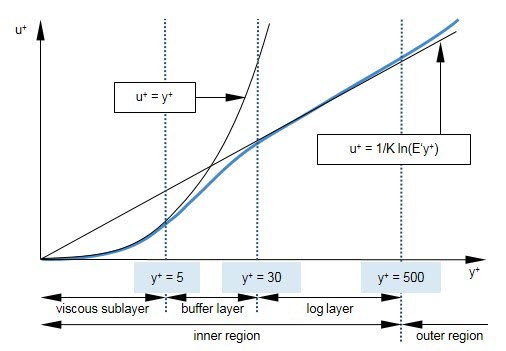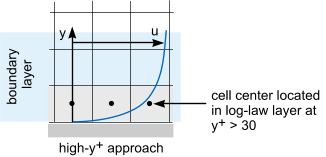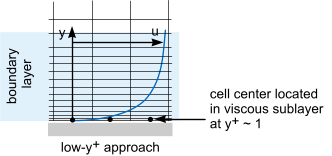Wall Treatment
Walls are a source of vorticity in most flow problems of practical importance. Therefore, an accurate prediction of flow and turbulence parameters across the wall boundary layer is essential.
The inner region of the boundary layer can be split up into three sublayers. In each of them the flow has different characteristics:
-
Viscous sublayer
The fluid layer in contact with the wall is dominated by viscous effects and is almost laminar. The mean flow velocity only depends on the fluid density, viscosity, distance from the wall, and the wall shear stress.
- Log layer
The turbulent log layer is dominated equally by viscous and turbulent effects.
- Buffer layer
The buffer layer is a transitional layer between the viscous sublayer and the log layer.
Each of the sublayers can be modeled using different empirical approaches. The non-dimensional wall distance , see Eqn. (1584), can be used to define the extents of the sublayers. The following plot shows the non-dimensional velocity , see Eqn. (1585), as a function of across the three sublayers:

Simcenter STAR-CCM+ provides the following types of wall treatment:
- High-
-
The high- wall treatment is equivalent to the traditional wall-function approach. This approach uses algebraic relations based on the assumed distribution of velocity, temperature, and turbulence quantities across the boundary layer to provide boundary conditions for the continuum equations. The accuracy of the wall-function approach depends on the degree to which the assumptions and approximations embodied in the functions correspond with the reality of the application. Most standard wall functions apply only to equilibrium conditions. However, Simcenter STAR-CCM+ extends the wall functions to include non-equilibrium effects.
This approach assumes that the near-wall cell lies within the log layer of the boundary layer at > 30. The main advantage of the high- wall treatment is therefore the significant savings in the number of near-wall cells.
- Low-
-
In general, the low- wall treatment is equivalent to the traditional low Reynolds number approach, where the boundary layer is resolved with a fine layered mesh and no modeling beyond the assumption of laminar flow is necessary to predict the flow across the wall boundary.
However, for robustness reasons, Simcenter STAR-CCM+ does not apply this approach but applies standard wall functions to obtain boundary conditions when the centroid of a near-wall cell lies in the viscous sublayer of the boundary layer.
To resolve the viscous sublayer, these models require a sufficiently fine mesh with near-wall cells located at of around unity. The computational expense that is associated with this approach can be significant, particularly for large Reynolds number flows where the viscous sublayer can be very thin. Therefore this wall treatment is suitable only for low Reynolds number flows.
- All-
-
The all- wall treatment uses blended wall functions that emulate the low- wall treatment for fine meshes, and the high- wall treatment for coarse meshes.
It is also formulated with the desirable characteristic of producing reasonable answers for meshes of intermediate resolution, that is, when the wall-cell centroid falls within the buffer region of the boundary layer. Therefore, this wall treatment is suitable for a wide range of near-wall mesh densities.

- Two-layer all-
-
The two-layer all- wall treatment, which is available for the two-layer turbulence models, uses an approach that is identical to the all- wall treatment. However, specific values of the turbulence dissipation rate are imposed at the centroids of the near-wall cells to make it consistent with the two-layer formulation of the underlying turbulence model.
Wall Treatment for Rough Walls
Roughness effects are a critical issue in various engineering applications. Even small surface imperfections can lead to significant disturbances in the velocity field and change the flow behavior and thus the performance of a product. In most cases, roughness structures are too small to be resolved by the mesh. Therefore, wall roughness models are employed.
In general, the effect of wall roughness is modeled by moving the log layer of the inner boundary layer closer to the wall. Simcenter STAR-CCM+ provides the following methods for incorporating this effect:
- Rough
- The Rough method calculates a roughness function that reduces the log law offset in the wall functions for velocity and temperature. This approach acts directly on the log law and assumes that the local roughness height is smaller than the wall distance of the wall-adjacent cell.
- Rough Displaced Origin
- The Rough Displaced Origin method displaces the origin of the boundary layer above the roughness height and applies modified wall functions for velocity, temperature, turbulent dissipation rate, and specific dissipation rate. Therefore, it is less sensitive to the mesh resolution and allows the combination of high roughness values with low-Re turbulence models.
Wall Treatment for Reynolds-Averaged Navier-Stokes Turbulence Models
Not all wall treatments are available with every RANS model or model variant. Some high Reynolds number models do not contain the ability to attenuate the turbulence in the viscous-affected regions and therefore only include a high- wall treatment. Low Reynolds number models are offered only with a low- wall treatment and an all- wall treatment. The two-layer all- wall treatment is only available with the two-layer K-Epsilon and the two-layer Reynolds Stress turbulence models.
The available wall treatments for the RANS turbulence models are listed in the Turbulence Models Lookup.
Wall Treatment for Scale-Resolving Simulations
Resolving the viscous sublayer for a Large Eddy Simulation is potentially expensive, since unlike RANS simulations, it is not sufficient to stretch the mesh only normal to the wall. The streaky structures that develop in the near-zero wall region also require adequate mesh definition in the spanwise and streamwise directions. Therefore, it may be desirable to avoid having to resolve the viscous sublayer and perform a wall-modeled large eddy simulation (WMLES) instead. To facilitate this choice, a low- wall treatment and an all- wall treatment are available.
The wall-shear stress is usually calculated using the velocity at the cell adjacent to the wall. However, using this cell as reference cell for WMLES can lead to an underestimation of the wall-shear stress (also called log-layer mismatch). To reduce this effect, Simcenter STAR-CCM+ uses the second cell away from the wall as reference cell by default.
Detached Eddy Simulations circumvent the challenging near-wall mesh requirements of Large Eddy Simulations. They solve the boundary layer by using RANS closure models. The available wall treatments depend on the RANS model that is used for closure, see Turbulence Models Lookup.